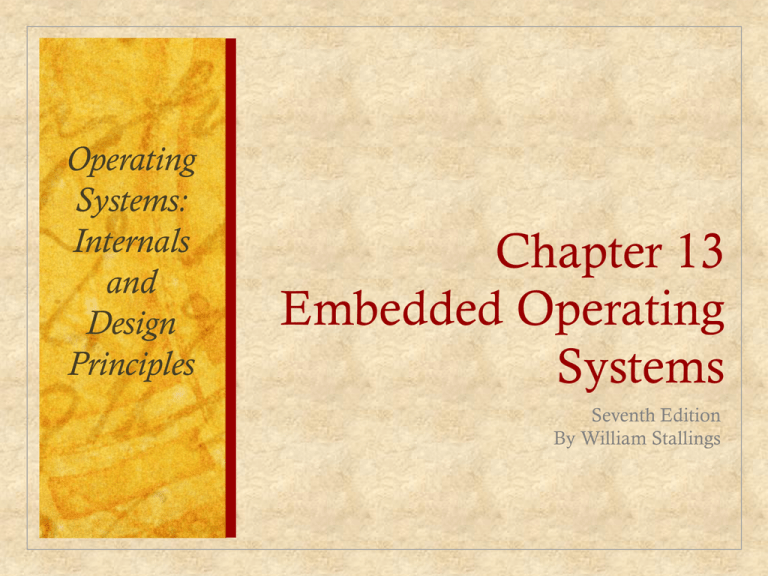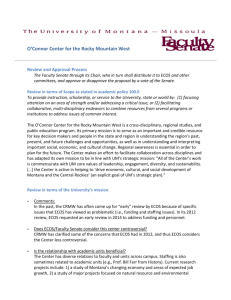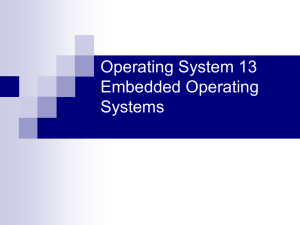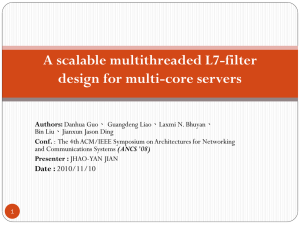Chapter13-OSedition7Final
advertisement

Operating Systems: Internals and Design Principles Chapter 13 Embedded Operating Systems Seventh Edition By William Stallings Operating Systems: Internals and Design Principles In brief, the conventional arguments that bird brains are too small or do not have particular structures needed for intelligence are based on ignorance of brains in general and bird brains in particular. It is unwarranted to argue that the small brains and small bodies of birds render them less capable of behaving with intelligent awareness than animals with large brains and large bodies. — THE HUMAN NATURE OF BIRDS, Theodore Barber Embedded System Refers to the use of electronics and software within a product that is designed to perform a dedicated function in many cases, embedded systems are part of a larger system or product antilock braking system in a car would be an example Examples of Embedded Devices Real Time Constraints Embedded systems are tightly coupled to their environment This imposes real-time constraints by the need to interact with the environment required speeds of motion required precision of measurement required time durations Embedded System Organization Design Differences In addition to the processor and memory, there are a number of elements that differ from the typical desktop or laptop computer: • there may be a variety of interfaces that enable the system to interact with the external environment • human interface may be simple or complicated • the diagnostic port may be used for diagnosing the system that is being controlled • FPGA, ASIC, or nondigital hardware may be used to increase performance or safety • software often has a fixed function and is specific to the application Characteristics of Embedded OS real-time operation reactive operation configurability I/O device flexibility streamlined protection mechanisms direct use of interrupts Developing an Embedded OS Two general approaches: • take an existing OS and adapt it for the embedded application • design and implement an OS intended solely for embedded use Adapting an Existing OS An existing commercial OS can be used for an embedded system by adding: real time capability streamlining operation adding necessary functionality Advantage: • familiar interface Disadvantage: • not optimized for real-time and embedded applications Purpose-Built Embedded OS Two examples are: Typical characteristics include: • eCos • TinyOS fast and lightweight process or thread switch scheduling policy is real time and dispatcher module is part of scheduler small size responds to external interrupts quickly minimizes intervals during which interrupts are disabled provides fixed or variable-sized partitions for memory management provides special sequential files that can accumulate data at a fast rate Timing Constraints To deal with timing constraints, the kernel: • provides bounded execution time for primitives • maintains a real-time clock • provides for special alarms and timeouts • supports real-time queuing disciplines • provides primitives to delay processing by a fixed amount of time and to suspend/resume execution Embedded Configurable Operating System (eCos) Open source, Royalty-free Real-time OS Intended for embedded applications Targeted at high-performance small embedded systems Implemented on a wide variety of processor platforms One of the most widely used embedded operating systems eCos Configuration Tool T o p L e v e eCos Configuration Tool K e D r t n a e i e Loading an eCos Configuration eCos Layered Structure Hardware Abstraction Layer (HAL) Presents consistent API to upper layers and maps upperlayer operations onto a specific hardware platform Different for each hardware platform HAL Modules Architecture The HAL Platform is implemented as three separate modules defines the processor family type contains the code necessary for processor startup, interrupt delivery, context switching and other functionality specific to the instruction set architecture of that processor family • extends the HAL support to tightly coupled peripherals like interrupt controllers and timer devices • defines the platform or board that includes the selected processor architecture and variant Variant • supports the features of the specific processor in the family • a memory management unit (MMU) would be an example eCos Kernel Design The eCos kernel was designed to satisfy four main objectives: low interrupt latency the time it takes to respond to an interrupt and begin executing an ISR low task switching latency small memory footprint deterministic behavior time from when a thread becomes available to when actual execution begins memory resources for both program and data are kept to a minimum by allowing all components to configure memory as needed throughout all aspect of execution the kernel’s performance must be predictable and bounded to meet realtime application requirements eCos Kernel Functionality The eCos kernel provides the core functionality needed for developing multithreaded applications: the ability to create new threads in the system, either during startup or when the system is already running control over the various threads in the system a choice of schedulers, determining which thread should currently be running a range of synchronization primitives, allowing threads to interact and share data safely integration with the system’s support for interrupts and exceptions Utilizing Kernel Functions Some functionality that is typically included in the kernel of an OS is not included in the eCos kernel: memory allocation is handled by a separate package each device driver is a separate package various packages are combined and configured to meet the requirements of the application for some embedded platforms the eCos kernel is not used at all Techniques: • use the C API of kernel • use compatibility packages for existing API’s eCos I/O System Framework for supporting device drivers A variety of drivers are available through the configuration package Principal objective is efficiency with no unnecessary software layering or extraneous functionality Device drivers provide the necessary functions for input, output, buffering, and device control Interrupt Model The kernel provides a three-level interrupt model: Deferred service routines (DSR’s) • invoked in response to a request by an ISR • will run when it is safe to do so without interfering with the scheduler Interrupt service routines (ISR’s) Threads • invoked in response to a hardware interrupt • may manipulate the hardware but is only allowed to make a restricted set of calls on the driver API • clients of the driver • able to make all API calls and are allowed to wait on mutexes and condition variables Table 13.2 Device Driver Interface to the eCos Kernel: Concurrency Table 13.3 Device Driver Interface to the eCos Kernel: Interrupts eCos Scheduler The eCos kernel can be configured to provide one of two scheduling designs: Bitmap scheduler • efficient for a system with a small number of threads active • configured with 8, 16, or 32 priority levels • only one thread can exist at each priority level at any given time • the scheduler need only determine the position of the most significant one bit in the bitmap to make a scheduling decision Multilevel queue scheduler • appropriate when number of threads is dynamic • allows multiple threads at the same priority level • time slicing Bitmap Scheduler Priority Levels Multilevel Queue Scheduler Priorities eCos Thread Synchronization The eCos kernel can be configured to include one or more of six different thread synchronization mechanisms Classic mechanisms: mutexes Synchronization/communication mechanisms event flags condition variables semaphores mailboxes SMP support(symmetric multiprocessing) spinlocks Mutex Mutual exclusion lock Used to enforce mutually exclusive access to a resource Has two states: locked and unlocked Can be configured to support either a priority inheritance protocol or a priority ceiling protocol Differs from a binary semaphore in two respects: the thread that locks the mutex must be the one to unlock it a mutex provides protection against priority inversion Using Mutexes In eCos, condition variables are typically used in conjunction with mutexes to implement long-term waits for some condition to become true Mutexes and Condition Variables Event Flags, Mailboxes, Spinlocks Mailbox Event Flag • 32-bit word used as a synchronization mechanism • application code may associate a different event with each bit in a flag • a thread can wait for either a single event or a combination of events by checking one or multiple bits in the corresponding flag • an eCos synchronization mechanism that provides a means for two threads to exchange information Spinlock • a flag that a thread can check before executing a particular piece of code • only one thread at a time can acquire a spinlock • should not be used on a singleprocessor system TinyOS Streamlines to a very minimal OS for embedded systems Core OS requires 400 bytes of code and data memory combined Not a real-time OS There is no kernel There are no processes OS doesn’t have a memory allocation system Interrupt and exception handling is dependent on the peripheral It is completely nonblocking, so there are few explicit synchronization primitives Has become a popular approach to implementing wireless sensor network software Wireless Sensor Network Topology TinyOS Goals With the tiny distributed sensor application in mind, the following goals were set for TinyOS: allow high concurrency operate with limited resources adapt to hardware evolution support a wide range of applications support a diverse set of platforms be robust TinyOS Components Embedded software systems built with TinyOS consist of a set of modules (called components), each of which performs a simple task and which interface with each other and with hardware in limited and well-defined ways The only other software module is the scheduler Because there is no kernel there is no actual OS The application area of interest is the wireless sensor network (WSN) Examples of standardized components include: • • • • • single-hop networking ad-hoc routing power management timers nonvolatile storage control The shaded box in the diagram indicates the component, which is treated as an object that can only be accessed by defined interfaces, indicated by white boxes A component may be hardware or software Each component can link to only two other components, one below it in the hierarchy and one above it TimerM Component Components -- Tasks A software component implements one or more tasks Each task in a component is similar to a thread in an ordinary OS Within a component tasks are atomic once a task has started it runs to completion A task cannot: A task can: • be preempted by another task in the same component and there is no time slicing • block or spin wait • perform computations • call lower-level components (commands) • signal higher-level events • schedule other tasks Components -- Commands A command is a nonblocking request a task that issues a command does not block or spin wait for a reply from the lower-level component Is typically a request for the lower-level component to perform some service The effect on the component that receives the command is specific to the command given and the task required to satisfy the command A command cannot preempt the currently running task A command does not cause a preemption in the called component and does not cause blocking in the calling component Components -- Events Events in TinyOS may be tied either directly or indirectly to hardware events Lowest-level software components interface directly to hardware interrupts may be external interrupts, timer events, or counter events An event handler in a lowest-level component may handle the interrupt itself or may propagate event messages up through the component hierarchy A command can post a task that will signal an event in the future in this case there is no tie of any kind to a hardware event TimerC Configuration The uppercase C stands for Component The uppercase M stands for Module The TimerC component, providing the Timer interface, is a configuration that links its implementation to Clock and LED providers TinyOS Scheduler Operates across all components Only one task executes at a time The scheduler is a separate component it is the one portion of TinyOS that must be present in any system Default scheduler is a simple FIFO queue Scheduler is power aware puts processor to sleep when there is no task in the queue Simplified View of the Surge Application Configuration for Surge TinyOS Resource Interface TinyOS provides a simple but powerful set of conventions for dealing with resources Dedicated • a resource that a subsystem needs exclusive access to at all times • no sharing policy is needed • examples include interrupts and counters Virtualized • every client of a virtualized resource interacts with it as if it were a dedicated resource • an example is a clock or timer Shared • abstraction that provides access to a dedicated resource through an arbiter component • arbiter determines which client has access to the resource at which time Shared Resource Configuration Summary Embedded system refers to the use of electronics and software within a product An existing commercial OS can be used for an embedded system by adding real-time capability, streamlining operation, and adding necessary functionality Embedded Configurable Operating System (eCos) is an open source, royalty free, realtime OS intended for embedded applications eCos kernel was designed to satisfy four main objectives: low interrupt latency, low task switching latency, small memory footprint, and deterministic behavior can be configured to provide the bitmap scheduler and multilevel queue scheduler designs The eCos I/O system is a framework for supporting device drivers TinyOS was developed primarily for use with networks of small wireless sensors TinyOS scheduler operates across all components A key design requirement for eCos is portability to different architectures and platforms with minimal effort








